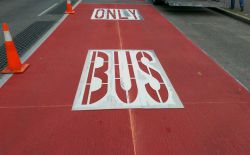Submission regarding BC Climate Leadership Plan and transportation GHG pollution:
BLOG POST posted on Avril 5, 2016 by edoherty
Submission regarding BC Climate Leadership Plan and transportation GHG pollution:
By Eric Doherty MCIP - www.ecoplanning.ca
Two Key Action Recommendations
The BC Climate Leadership Plan is extremely weak on the potential to reduce GHG pollution in the transportation sector (Recommendation 19). And I am sure other submissions have pointed out that biofuels and LNG do not necessarily reduce lifecycle GHG pollution. But there are cost effective ways to strengthen the Plan and also achieve other important objectives such as reducing local pollution and improving public health.
Globally, transportation is the fastest growing source of carbon pollution and Environment Canada expects that Canada’s transportation pollution will be higher in 2020 than in 2012, unless much stronger action is taken. About a quarter of Canadian carbon pollution comes directly from the transportation sector – from the tailpipes of cars, trucks and airplanes, and that does not include the pollution from extracting and refining fuel or building new roads and bridges.
The benefit of BC showing real leadership on low-carbon transportation is not just the reduced GHG pollution in BC and side-benefits of improved health and reduced local air and noise pollution. BC is looked to internationally for leadership on urban issues, so a good example here would stimulate similar action in other provinces as well as the US, China, India and other jurisdictions.
Two Key Actions:
There are a large number of actions that could reduce transport GHG pollution to some degree. But I will focus on two key actions that would have a negative net cost; that is, they would be worthwhile doing even without the benefit of reduced GHG pollution:
1) Reallocate Resources: The most obvious missing action is to reallocate financial resources from projects that increase GHG pollution to projects that reduce GHG pollution. Roadway and airport expansions induce demand for high-carbon transportation[1]. Improving public transit, highway bus and passenger rail transportation tends to reduce GHG pollution, as does investing in sidewalks and cycling facilities. Carefully reallocating resources is likely to have a negative net cost when all the benefits including health benefits and the reduced financial costs to individuals are considered.[2]
The potential to reduce GHG pollution by reallocating resources is considerable; for example the $3.5 Billion now proposed now proposed to be spent on the 10-lane Massey Tunnel replacement bridge could greatly improve sidewalks and cycling facilities province wide.
2b) Reallocate Road Space on Zurich Model: Long experience and numerous studies shows that traffic volumes expand and contract with the amount of road space, without travel speeds for cars and trucks changing much.
The cliché ‘you can’t build your way out of congestion’ is backed up by strong evidence.[3] Even most non-experts understand that widening urban roads or freeways leads to wider traffic jams and more pollution. What happens is called ‘induced congestion’ – the extra road space encourages people to drive more until congestion is severe enough to start discouraging driving again. Induced congestion can be very quick; for example the Alex Fraser Bridge in Metro Vancouver was heavily congested within a year of opening.
The inverse of induced congestion is sometimes called ‘disappearing traffic.’ In her 1961 classic The Death and Life of Great American Cities Jane Jacobs wrote about how after the road through Washington Square Park in New York was closed “cars – just disappeared into thin air.” Traffic did not increase on the surrounding streets as many had predicted. Over the last half century, many similar experiences of disappearing traffic have been documented.[4] And since a bus lane can carry five to ten times as many people as a lane of cars, well designed bus lanes can handle decades of increasing transit ridership on most routes.
The most dramatic road space re-allocation ever took place well before the climate crisis was making unprecedented floods and other disasters the new normal. After the 1973 oil shock Zurich Switzerland created a still unprecedented network of exclusive transit lanes and signal priority for both streetcars and buses. At that time transit signal priority (traffic signals designed so that transit vehicles don’t have to stop at traffic lights) had to be invented from scratch. Now multiple manufacturers provide transit priority systems. Every year the Zurich transit authority gets closer to its goal of never having transit passengers delayed by cars.
Zurich now has the highest transit ridership in Europe, largely created with cans of paint and cleverly applied electronics controlling traffic lights. And traffic congestion is less of a problem than in most European cities. Many juristictions worldwide are now reallocating large amounts of road space from general purpose traffic to cycling and walking, which reduces GHG pollution while improving health and reducing the amount individuals have to spend on transportation.
Road space is already publically owned, largely by municipalities but also by the provincial government. The provincial government should create strong financial incentives for municipalities to reallocate road space to low carbon transportation, particularly to bus and bicycle lanes.
The site for the Vancouver local of The Media Co-op has been archived and will no longer be updated. Please visit the main Media Co-op website to learn more about the organization.
